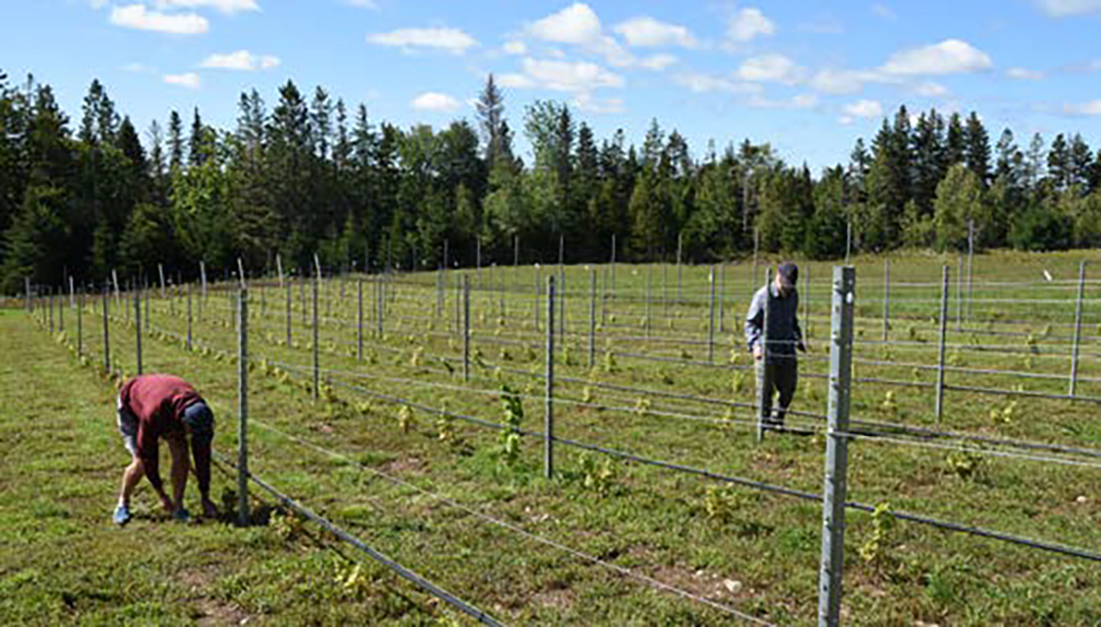Pinot Noir & Chardonnay By-The-Sea

This article originally appeared in the Winter 2021/2022 print issue of Quench Magazine.
It was not that long ago that Canadian experts in grape growing would have declared that Pinot Noir and Chardonnay were not financially viable for a winery anywhere in the country. This was debunked in the late ‘80s through ‘90s in Niagara, Ontario and British Columbia’s Okanagan Valley, and then emphatically proven to be a very silly thought in the decades to come, from coast to coast.
Canada is making some of the best wines in the world from Burgundy grapes, both as sparkling and still wines. Most of these are being grown in Niagara and BC. But there are excellent versions from the cold terroir of PEC (Prince Edward County), Ontario, where they typically have to bury the vines in the winter, and more recently from selected spots in Nova Scotia. In parts of the Annapolis Valley, the climate during the growing season is very similar to Chablis and Champagne, and the winters aren’t nearly as cold as PEC or Quebec, where they have also buried vinifera vines with some success.
Still, it seemed unlikely when someone planted Pinot Noir vines in St. Andrews By-The-Sea, the idyllic New Brunswick town that looks across the seasonally whale-filled waters to Maine. While New Brunswick has some successful wineries using cold-hardy hybrids, it is hard to ripen vinifera grapes like Chardonnay and Pinot Noir in the shorter growing season, particularly with the added risk for winter damage and spring frosts from the cooler winters.
Even more unlikely is the fact that Robert Cyr and Paul Leger, his brother-in-law and partner in the project, did not bury the vines.
Cyr is a New Brunswick government employee with a Masters in Engineering who specialises in improving service using a process engineering mindset. “Paul and I had never sat on a tractor before. We were a couple of guys who work in offices.” But his engineering mind proved valuable.
He home brewed in the ‘90s as a hobby but eventually started thinking about distilling – grapes and wine. “I wanted to show my kids that dreams are possible,” says Cyr, “to see that I can take an idea and use a set of actions to get things done. I liked the idea of something incremental; you can plant more vines every year, ramp it up and learn new things along the way.”
In 2019 Cyr studied temperatures in different parts of the province, looking at GDD (growing degree days), and came up with his own model for predicting the best areas for temperature and soils. This led him to Saint Andrews, where Leger lived. On looking around they found a promising bit of land on a nice south facing slope right next to the Rossmount Inn, one of the region’s best restaurants, owned and operated by Swiss ex-pats Chris and Graziella Aerni. “I wasn’t sure at first who owned the land but knew it was next to the Rossmount. Paul said ‘I’ll ask Chris tomorrow, we’re playing golf.’ Chris said ‘You had me at grapes.’”
Land was cleared and prepped, largely by Aerni, and soil testing was done with government help. The drainage was great due to the amount of sand in with the clay, so they did not need drainage tiles. The pH was low but that was easily adjusted with lime. In Spring 2020, they planted 50 Pinot Noir vines, 25 of clone 115 and 25 of clone 82, all bought from Vinetech in Ontario.
Cyr credits Aerni’s friend Hanspeter Stutz of Nova Scotia’s Domaine de Grand Pré winery for suggesting Burgundy grapes when they walked the site during a 2019 meeting at Rossmount.
Instead of burying the vines they made their own A-frame trellis set-up, with a winter fabric to keep the vines warm. It worked. They had no issues with winter kill.
Based on this success they committed to plant more vines in June of 2021. Because of the Pinot Noir shortage they ended up with 300 Chardonnay (clone 95), and 250 Pinot Noir (mostly clone 777 with a trial of ten 667). They also went with a commercial trellis system with the protective winter fabric for this year. Fingers are crossed.
It is still early, but they are optimistic. Cyr and Leger plan 14 more rows in 2022, and eventually hope to get to 50 rows. Eventually they will build a small winery and Cyr plans to become properly educated as a winemaker. Depending on yields, the production could be in the range of 1000-2000 bottles per year.
If all goes well, St. Andrews By-The-Sea could be another notable Canadian destination for Burgundy grapes.
NOTE: Cyr is very thankful for the help he received along the way, including from the Aerni’s – where would they be without the land? – but also David Craw and Sonia Carpenter from Motts Landing Vineyards for advice and inspiration, and the folks at Vinetech and Dubois Agrinovation.
